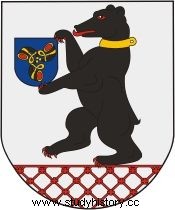Recently, the voices of animal defenders are resounding again, and the Internet is full of indignation at the mistreatment of pets. I wonder what the Gypsy bear cubs would say ...
In the Polish-Lithuanian Commonwealth, people liked to see the wonders of nature. Magnates brought negroes to their courts, the skins of lions, tigers and panthers were a hit among the hussars, and the gypsies leading trained bears on chains were eagerly watched both in noble estates and on city streets. Where did such educated bears come from? Well, they had their own academy.
In Europe, Poland was known from two academies. One of them - the Krakow Academy - educated students from various parts of the Republic of Poland and from neighboring countries. The second, commonly known as the Smorgon Academy, also carved young minds, although walking on four feet. The ability of shaggy students has become even proverbial. Thanks to them, in Old Polish, someone who did not bear intelligence was called "Smorgon's bagpipe", while a poor dancer moved "with the grace of a Smorgon graduate".
Where exactly did this famous academy come from?
There is evidence that the Gypsies-Bears lived in Poland as early as the 16th century, although it is not known when exactly they came to them. One thing is certain - apart from boilermaking, horse trading, blacksmithing and theft, bear training was one of the most popular activities among the Roma population.
The Gypsies living in Lithuania were taken care of by Prince Karol Radziwiłł, "Lord lover". They eagerly settled in his Smorgonie, where they were engaged in various crafts, and they were led by Gypsy "kings" appointed by the prince. One of the tasks of the latter was to create something like a school for bears, which were to undergo a proper training under the watchful eye of skilled tutors.
Shaggy students start their education

How to teach a teddy bear to dance?
Lithuania has long been overgrown with forests. And in the forest, as in the forest, animals lived happily and carefree (unless some noblemen wanted to hunt). The bear was, of course, the uncrowned king of the Lithuanian forests. From time to time, the "professors" of the Smorgon academy would go to the forest and catch young bear cubs, which then joined the ranks of their school.
Several dozen students studied at the academy at once. Similarly to the University of Kraków, this university was not co-educational and young bears were not allowed to enter it. The procedure for admitting the four-legged young man to the academy was not too complicated. As elsewhere, no baptismal certificate or smallpox vaccination certificate were required, and the pedigree was clearly visible at first glance. Interestingly, foreigners were also admitted, or rather foreigners - Prince Radziwiłł sent a few monkeys to the school.
Whoever gave his bear to study had to take into account the costs. At the beginning, it was necessary to discuss financial matters - something had to be paid for board and lodging for the bear. In addition, a special tutor was arranged for him who took care of the education of the teddy bear.
How Teddy Bears Learned to Dance
The class in which the little bears were taught to dance was a large room with a tiled stove instead of a floor. In the middle there was a large wooden pole, to which the schoolboy was tied with a strong rope, so that having enough "lessons" he would not run away by accident. The teaching itself was as follows:it was kindled in a furnace and heated almost to redness, and then a bear cub was introduced with bare front paws, and hind legs shod in onuce and paws. When the student was on the hot floor, Gypsy began to play the violin or the pipe. The bear cub, scalded in its front paws, quickly stood on its hind legs (protected by shoes) and performed movements similar to a clumsy dance. Anyone who studied biology about Mr. Pavlov's doggy will guess how the bear reacted later to the sound of a violin and pipes.

The coat of arms of Smorgonia, now located in Belarus, still features a bear
Nowadays, the realities force many students to look for a job in order to provide for themselves. It was similar in the Smorgon Academy. The students there also worked frequently during their six-year education. They went with their guardians on tourne they collected money at noble courts and cities and for showing tricks, a large percentage of which went naturally to the purse of the Smorgon academy.
Like all students, Smorgon bears had their holidays, albeit on a slightly different date. Mother nature thought that the poor bear must sleep through the winter. In the spring, graduates of the university in Smorgonie set off into the world, in the autumn they must return to their Alma Mater . In the school building there were rooms where teddy bears fell into hibernation. In the period from November 1 to February 15, in rooms covered with leaves, needles and branches lined with lairs, the bears had their holidays.
Today there are no real bearish players anymore…
The Smorgon academy experienced its heyday in the 18th century, and at the beginning of the 19th century, Gypsies with trained bears were regular guests in villages and towns. The school was closed during the November Uprising. At the end of the nineteenth century, an ordinance was issued in Warsaw prohibiting bear cubs and their charges from entering the city. Guided tours of the bears were also forbidden in other towns and villages. Nevertheless, even before World War II, bear cubs appeared in the territories of the Second Polish Republic and wandered around the villages with bears on chains.
As it turns out, driving bears is not a completely extinct profession. To this day, it has survived in southern Europe. Unfortunately, the fate of the teddy bears in the care of local bears is dismal. Standard practice is to knock bear cubs' teeth and cut their claws to make them vulnerable. The old training techniques have been abandoned. It was only since 2002 that a law protecting bears has been in force in Bulgaria. A foundation was also created to take care of bears taken from their former owners.
